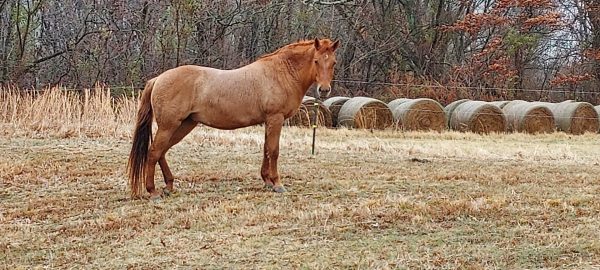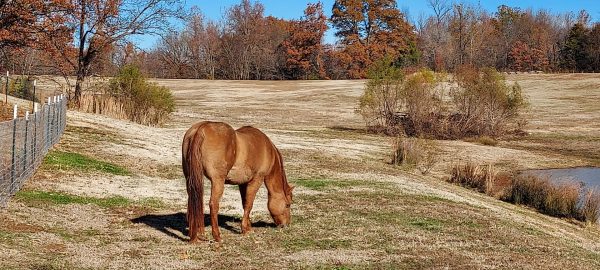 Saturday, Dec. 19, 2020, six days before Christmas. The Christmas animal auction, a west Tennessee annual tradition in Gleason. Tack, tchotchkes, goats and their kids, ducks and geese, ponies, and horses (lame, sound, in various stages of injury).
Saturday, Dec. 19, 2020, six days before Christmas. The Christmas animal auction, a west Tennessee annual tradition in Gleason. Tack, tchotchkes, goats and their kids, ducks and geese, ponies, and horses (lame, sound, in various stages of injury).
The day wet and cold, inside the auction barn little better — warmth coming only from brought blankets and cheap coffee from the concession stand. Filled to capacity, the hours-long parade of junk and lives for sale to the highest bidder began at mid-day and wasn’t complete until well past dark. The damp, humid, cold-in-your-bones air not an ideal indicator of the coming Christmas holiday.
The sale kicked off with a heap of cheap Chinese junk (from household items to toys and other novelties). We stumbled about, attempting to find our bearings, watching others navigate the tight lanes of bleachers, Amish baked goods, and wranglers working the crowd. Excited to experience the entirety of the landscape before us, we slipped to the back of the building, to the holding stalls where animals were kept.
Through the sliding wooden door, we immediately met the scent of sour manure, stale (even sick) cold air, and the restlessness of countless livestock pacing from fear and nervousness from the hundreds of human eyes and thousands of prodding fingers examining their worth, quality and well-being.
 Having spent years of my youth in farmland in rural South Dakota, I know that life in and around livestock is not always pleasant. It’s rarely clean, overly glossed by the city-based publications that tout “fresh from the farm” and “farm fresh” trademarks to their unaware urbanites who don’t often wonder about the origin of their pork chops and cheeseburgers. The truth is far dirtier and usually much darker than most people would prefer or dare to contemplate.
Having spent years of my youth in farmland in rural South Dakota, I know that life in and around livestock is not always pleasant. It’s rarely clean, overly glossed by the city-based publications that tout “fresh from the farm” and “farm fresh” trademarks to their unaware urbanites who don’t often wonder about the origin of their pork chops and cheeseburgers. The truth is far dirtier and usually much darker than most people would prefer or dare to contemplate.
Many of the animals at events such as these are here to move. Their owners seeking a new opportunity or fresh start, a way to discard a troubled animal, and an outlet for their home-breeding programs (think goats, ducks and other fowl, and rabbits); some of the owners want quick cash during challenging times. A Christmas sale might provide needed cash for gifts beneath the tree. The lives sold in these barns are business. Their worth subjective. Their futures long for some, more pleasant for others.
In many cases, the animals here are meat, including the horses. The animals here, by and large, particularly the horses and other equine, are not among the highest quality, at least in their present state.
Making our way through the isles of stalls, we encounter spinning horses with ears pinned and eyes white; mules and donkeys pulled with great effort and might into box stalls; shivering kids (baby goats) not yet weaned and too young for sale; squawking, flightless birds; and, in one case, a once thick red Dunn mare standing aloofly at attention, her eyes soft, her ribs showing slightly through her hide, but peaceful and unassuming.
Amid the squalor and chaos stood this horse, in a stall at the far corner of the barn, furthest from the barking and chaos, calm among the surrounding storm. She was receptive to our touch, not aggressive, her demeanor casual.
 “Hey, there. Take me home,” she seemed to say.
“Hey, there. Take me home,” she seemed to say.
Okay!
And that’s how and where we first met “528.”
Her name is now Twix. She’s the first horse to come to the ranch, though not the first of ours to own (that was Snickers).
She’s been here more than a year. She’s lead mare, queen of the ranch. She’s aloof. Sometimes throws her head and pins her ears. When food is at stake, she’s first in line and keeps the others at bay. But she chose me! Horses will do that. She did that in the barn as I sat there in a chair outside the arena, watching the girls work with our trainer. Right up to me, behind me, she stood still and firm, smelling my hair but otherwise unmoved. She did so for several minutes as if to say, “You’re the one I want to push around.” It was a great honor for a man who spent most of his life seeing horses as two-dimensional.
We’ve been working together for months. First in the arena, then in the round pen. Lunging, figure-8s, Parelli games, and pressure-and-response, working toward the saddle. Rarely does she want to work. She’ll nip the rope and tell me no, but if she’s not working, she gains weight quickly. She almost foundered over the summer when the grass was rich and green, but we got her weight under control, and she looks healthy again, though still round.
But we fare well with each other, and I appreciate her leadership in the herd. Without her, the others flounder a bit. She keeps their feet moving and anchors them, as any horse leader should.
 There are times when, after we’ve worked, she acts like she doesn’t want me to leave. She joins up with me for a moment, says hello with soft eyes, and seems to beg me to stay awhile longer with her in the pasture.
There are times when, after we’ve worked, she acts like she doesn’t want me to leave. She joins up with me for a moment, says hello with soft eyes, and seems to beg me to stay awhile longer with her in the pasture.
Tonight, after months of wondering, I realized I’m capable of loving a horse. I’ve had my suspicions, but after more than a year of her company, I’m certain of it. She has my heart, that brute force of muscle and mass formerly known as “528.”
